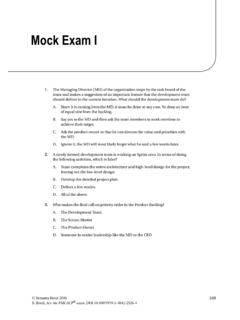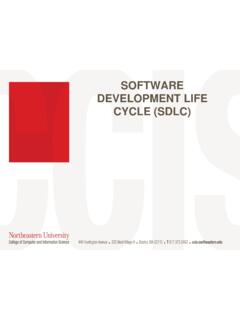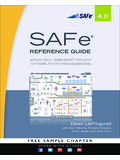Transcription of SCRUM in Agile - Scrum Alliance
1 BASICS OF SCRUM IN Agile Abstract Basic SCRUM handbook for the beginners in the Agile world and CSM (Certified SCRUM master ) aspirants. SudaRamakrishna Thiparthy CSM , ITIL References: SCRUM Alliance classroom training Contents Definition of SCRUM .. 2 Standards of SCRUM .. 2 Estimation and Techniques .. 2 Agile Manifesto .. 2 SCRUM master .. 3 Product Owner .. 3 SCRUM Roles and Responsibilities .. 3 Development Team .. 3 Typical Sprint Phases .. 4 1. Product Backlog: .. 4 2. Sprint Planning .. 4 3. Sprint Backlog .. 4 4.
2 Sprint .. 4 Sprint Burn- down charts .. 6 5. Daily SCRUM .. 9 6. MVP (Minimum Viable Product) .. 9 7. Sprint Review .. 9 8. Sprint Retrospective .. 9 Typical Sprint flow Diagram .. 9 SCRUM Jargon .. 10 Definition of SCRUM SCRUM is one of the Agile frameworks followed to complete challenging projects wherein there are dynamic changes in the requirements by using one or more cross- functional, self- organizing teams of about 7 +/- 2 people on each team. Standards of SCRUM SCRUM consists of 3 roles: product owner, ScrumMaster, and development team/engineering team.
3 Roles and responsibilities of each role will be elaborated in the following sections. SCRUM uses fixed- length iterations called sprints ranging from one Week four weeks (or 30 days long). SCRUM teams should consist of 7 +/- 2 people. Sprint cannot exceed more than 30 days. Sprint is time bound. SCRUM team aims to build a potentially shippable product by end of each sprint. Daily SCRUM / Stand- up meeting should be only for 15 mins. and as the name goes, the team should be standing during entire meeting time. Estimation and Techniques It s nowhere a rule saying you have to adopt one of the techniques to estimate.
4 The team can use any logic to estimate their user stories. Once the team has worked for awhile in Agile projects, their ability to estimate the user stories becomes much better and more accurate. But teams new to Agile sometimes face difficulty in estimating the points for the user stories. Below are the few estimation techniques, which can be used to estimate the user stories accordingly: Planning Poker Planning Poker is a game that the team members can play during planning meetings to make sure everyone participates. To begin with, each team member is given with set of cards with numbers on them.
5 Usually the team follows the Fibonacci sequence: 0, 1, 2, 3, 5, 8, 13, and 21. Then each story is read aloud. After each story presentation, each of the team member is asked to hold up the card showing the level of effort involved according to them. Once every team members gives the points for the story, the one with lowest value and the one with highest value will be asked to explain why they have chosen that value. Experts with detailed knowledge will be able to explain to the team why a certain story is much easier/more difficult than it first appears.
6 Then the team will come to an agreement on the estimate for that user story and conclude on that. T- Shirt Sizes At times it happens that the team members start aligning the story points with the hours of effort, which can create confusion. To avoid this, it may be more effective to switch to a non- numeric estimation technique. With T- Shirt Sizing, the team is asked to estimate the story effort in terms of extra- small, small, medium, large, extra- large, or double extra- large. By removing the numeric concept, team will be free to think in more abstract way.
7 But there is a practical issue involved with this method. Non- numerical scales are generally less granular. While that can speed up the voting process by reducing the number of options, it may also reduce the accuracy of velocity estimates. For the above reason, the T- Shirt Sizes method of estimates will be good for the teams just starting with Agile projects. Eventually it s a good idea to move toward numeric method of estimation. Relative Mass Valuation Usually the process of deciding the story point for each story will consume lot of time. With this method, it consumes less time.
8 All the stories are written on cards and then a large table is setup and all cards are placed on the table. Pick any story and start comparing the remaining stories one by one in terms of small, medium or relatively large. If the compared story is relatively large, that card is placed at one end of the table. If the story is small, it s placed at the other end of the table and if the story is medium, it s placed in the middle of the table. Now select the next story and ask the team to estimate if it s more or less effort than the story that you just put down.
9 Position the story card on the table relative to the previous card, and go to the next card. Next step is to assign the points to the cards starting with the easiest story and assigning 1 to that. Keep on assigning 1 point to the further stories in the sequence until you get to a story which seems to be twice difficult as the first one, assign 2 points to that story. Accordingly give the points to the other stories. Agile Manifesto While there is value in the items on the right, we value the items on the left more: Individuals & interaction over Processes & Tools Working software over Comprehensive Documentation Customer Collaboration over Contract Negotiation Responding to Change over Following a Plan SCRUM Roles and Responsibilities Product owner Responsible person for release burn- down chart.
10 Responsible for the product vision. Person who maintains the product backlog and the responsible person for the same. Only person who can make a decision whether the product is ready to ship. Only authoritative person to take a decision about abruptly discontinuing/stopping the sprint. Person responsible to provide clarification on the user story to the development team whenever needed. Only authoritative person to take the decision of including any further functionality to the product backlog. Person to constantly reprioritize the product backlog. ScrumMaster Facilitator of the SCRUM process.








